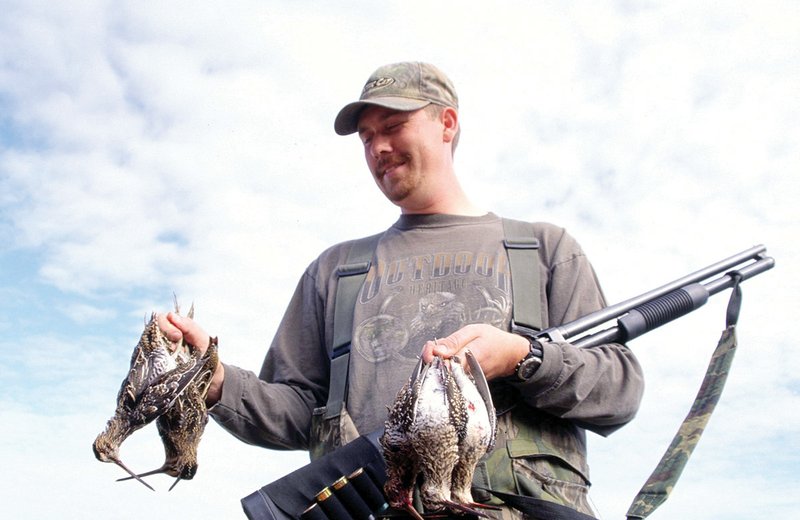“Why is it you like hunting snipe?” a friend asked me one day after I had left our duck blind and put two of the longbills in my game bag. “You wear yourself out wading through mud and marsh grass, hoping to find some little brown birds barely the size of anorexic quail. Each one flushes underfoot and scares the wits out of you. You twist yourself into a knot trying to shoot them before they sputter away, and if you’re really lucky, you’ll actually kill one or two. What do you have to show for all this effort? Bite-sized pieces of meat that’ll barely make an appetizer.
“I just don’t understand it,” he said.
“It’s fun,” said I.
“Then maybe it’s not just the birds who are gooney,” he replied.
I felt it best to withhold the fact that I also hunt coots.
Hunting webless migrants — wetland birds such as snipe, coots, rails, moorhens and gallinules — is an acquired taste. Many hunters consider it a waste of time, energy and ammunition. But when waterfowl hunting is slow, pursuing these birds may liven up the day.
Snipe
If you thought “snipe hunting” was just a prank played on gullible kids, think again. Snipe are real, and they’re very sporty gamebirds. About 30,000 U.S. hunters pursue them each year, killing almost 100,000. Hunting grounds in Arkansas include open marshes, mud flats, rice fields and open pond edges.
Snipe often fly over duck blinds, and duck hunters probably bag more snipe than other hunters. Jump shooting is the most common snipe-hunting technique, however. Hunters spread out in proper habitat, guns at the ready, and walk the birds up. Others stalk snipe from shallow-draft boats, poling through snipe habitat to flush their quarry.
Snipe usually hold tight, allowing one to approach within shotgun range. The birds are ghosts on the ground, however; it’s a rare hunter who can spot one before it flushes. Just when you decide you’ve made a mistake in marking him, the snipe jumps from a spot where you just looked. It flies as though it doesn’t have any idea where it’s going but, nevertheless, is in a terrible hurry to get there.
Fast, accurate gun handling is a must. The snipe’s erratic flight and small size make it an extremely difficult target. Straight-away shots are rare. Instead, the snipe moves much like a balloon that’s been inflated and suddenly turned loose. Any hunter who bags two birds for every five shots fired deserves all the respect one can muster.
Coots
Of all our common gamebirds, perhaps none is less hunted than the American coot. These rail family members frequent flooded crop fields, lakes, ponds, marshes and other watery habitats. I have seen, on some Arkansas waters, flocks of coots numbering in the thousands. Rarely are they alone, preferring groups of a few to many birds. They’re usually in shallow water feeding on aquatic vegetation and invertebrates.
Many coots are killed by hunters who are bored by lack of action for other waterfowl. They can be hunted by design rather than accident, however, by scouting for flocks and boating into a position where you can hide and ambush them. They love the security of flooded willow thickets, and I’ve taken many by wading into such an area and stalking them with a shotgun.
As table fare, a coot won’t equal a plump acorn-fed mallard. But the coot’s dark meat has a hearty wild flavor that is well-suited to a variety of tasty recipes.
Rails
Rails aren’t hunted much, not for lack of huntable numbers, but because most hunters know little about them. These secretive birds usually hide in dense marsh vegetation, flying only when hard-pressed. Few sportsmen see rails because few look for them.
In Arkansas, two species — sora and Virginia rails — can be hunted. On the Gulf and Atlantic coasts, where rail hunting is most popular, they’re hunted most often by poling flat-bottomed boats through marsh grasses, using the boat as, say, a 14-foot flushing dog. You could try the same in Arkansas cattail marshes and rice fields.
Florida hunters flush rails with pebble-filled cans tied to a cord dragged between the hunters. Rails let hunters walk right past them without flushing, but when that cord and cans come over them, the birds fly, and a hunter bringing up the rear shoots what he can.
Rails are great confidence builders. They can make it seem as if you’re a good wingshot. You see, “marsh hens” fly less than fast. If they were airplanes, they’d be C-130s with two engines out. Their flight is slow, low and lumbering. Straight away, too. Miss more than one or two, and you should be considered too dangerous to handle a gun.
Gallinules and Moorhens
Purple gallinules and common moorhens, also members of the rail family, are among our least-hunted gamebirds. Gallinules are very uncommon, but moorhens can be found in good numbers in proper habitat in southern parts of the state. Look for them in dense vegetation around ponds, marshes and lake edges. They’re often seen walking on lily pads or feeding along edges of open water. Hunting them from boats is best, as walking in their marshy, mucky habitat is difficult. Coot- and rail-hunting tactics work great.
Many wingshooters consider it crazy to hunt snipe, coots, rails, gallinules and moorhens.
“They’re just gooney birds,” some say. “Why waste my time on them?”
Discover the truth yourself. The real allure of hunting webless migrants must be experienced to be understood.
